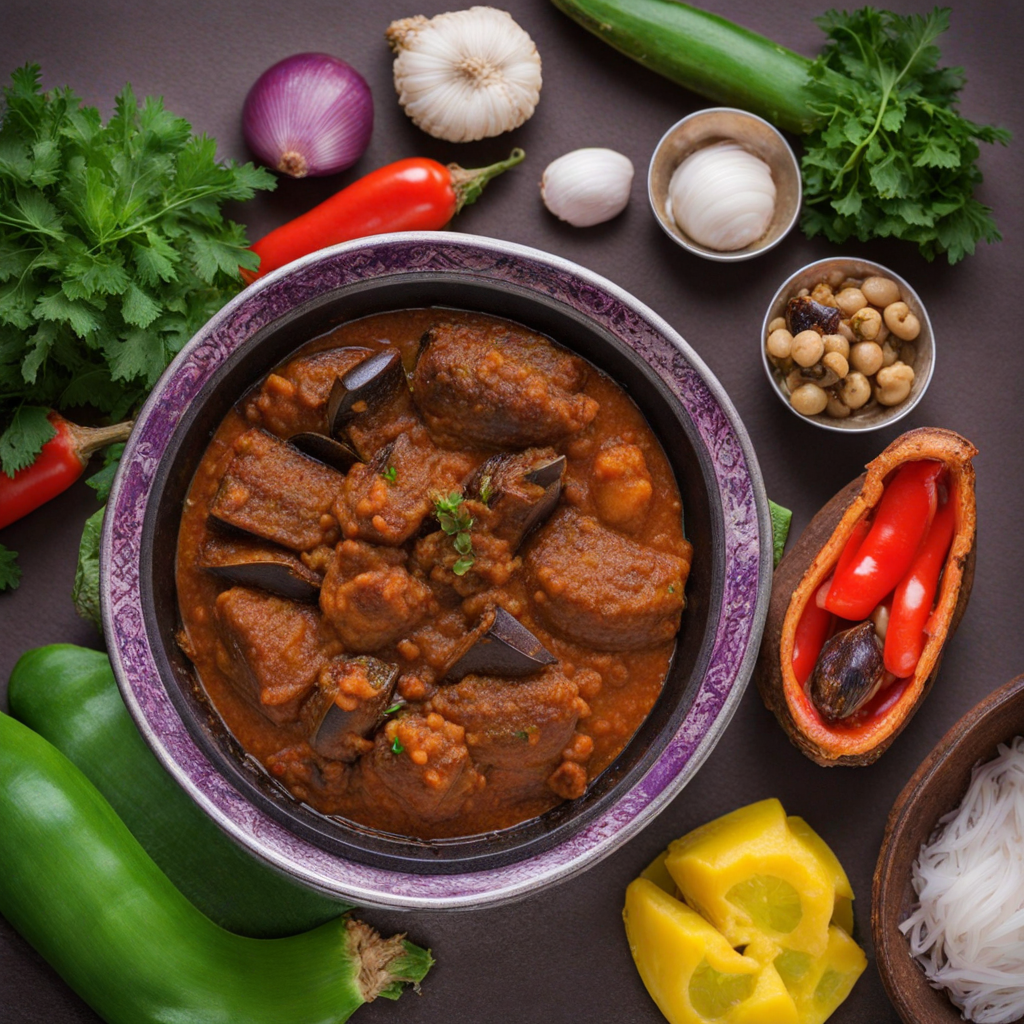Akpessi
Akpessi is a delightful dish from Benin that showcases the rich culinary heritage of West Africa. This tantalizing meal typically features fish, often marinated and grilled to perfection, bringing forth a smoky flavor that is both aromatic and savory. The fish is usually seasoned with a blend of spices and herbs, including garlic, ginger, and local spices that add depth and character. The grilling process not only enhances the taste but also gives the fish a beautiful char, making it visually appealing and mouthwatering. A hallmark of Akpessi is the accompanying sauce, which is often made from a base of tomatoes, onions, and a variety of peppers. This sauce is cooked until thick and rich, allowing the flavors to meld beautifully. The heat from the peppers is balanced by the sweetness of the tomatoes, creating a vibrant and flavorful condiment that complements the grilled fish perfectly. Served alongside the dish are often sides such as plantains or yams, which add texture and heartiness to the meal, making it fulfilling and satisfying. What sets Akpessi apart is not just its taste, but also the communal experience that often accompanies it. Traditionally served in a shared setting, this dish invites people to gather around and enjoy the flavors together, fostering a sense of community. The combination of the smoky, spicy fish with the fresh, zesty sauce creates a taste sensation that is both unique and memorable. For those looking to explore new flavors, Akpessi offers a delicious window into the culinary traditions of Benin, making it a must-try for any food enthusiast.
How It Became This Dish
The History of Akpessi: A Culinary Gem from Benin Introduction Nestled in the vibrant tapestry of Benin's culinary landscape, Akpessi stands out as a dish that encapsulates the country's rich cultural heritage and historical evolution. This traditional delicacy, primarily made from cassava, offers a delectable experience that interweaves the agricultural practices, social dynamics, and cultural expressions of the people of Benin. Origins of Akpessi The roots of Akpessi can be traced back to the indigenous peoples of the Benin region, where cassava (Manihot esculenta) has been a staple food for centuries. Initially brought to Africa from South America by Portuguese traders in the 16th century, cassava quickly adapted to the African climate and became a vital crop. Its high carbohydrate content and resilience in poor soil made it an ideal food source for many communities. The process of transforming cassava into Akpessi involves a series of traditional steps. First, the cassava tubers are harvested, peeled, and then grated or ground into a fine paste. This paste is then fermented, giving Akpessi its distinctive tangy flavor. The fermentation process is an ancient practice that not only enhances taste but also increases the nutritional value of the dish. Once fermented, the mixture is shaped into small cakes and often wrapped in banana leaves, which impart a unique aroma during the cooking process. Cultural Significance Akpessi is more than just a dish; it is a cultural symbol deeply embedded in the social fabric of Benin. It is often served during communal gatherings, celebrations, and rites of passage, reflecting the importance of food in fostering community bonds. The preparation of Akpessi is frequently a communal activity, with families and neighbors gathering to share in the labor and joy of creating this beloved dish. In many Beninese cultures, food is a medium of storytelling and tradition. Akpessi, often accompanied by a variety of sauces or soups, serves as a centerpiece during feasts, symbolizing abundance and hospitality. It is also a dish that transcends social classes, enjoyed by both the wealthy and the less affluent, which reinforces its role as a unifying food in Benin. Development Over Time As with many traditional foods, Akpessi has evolved over the years. In the early 20th century, with the advent of colonialism and the subsequent influence of Western culture, the way Akpessi was prepared and consumed began to change. Although the fundamental ingredients and methods remained intact, new cooking tools and techniques were introduced that made the preparation process more efficient. Post-independence in 1960, there was a resurgence of interest in traditional foods as part of a broader movement to reclaim cultural identity. Akpessi was celebrated not only as a delicious meal but also as a symbol of national pride. Efforts to promote local cuisine gained momentum, and Akpessi found its way onto menus in restaurants and homes alike, often served alongside modern culinary creations. In contemporary Benin, Akpessi has transitioned from a purely traditional dish to one that embraces innovation. Chefs and home cooks alike experiment with new flavors and presentations, incorporating various local ingredients such as dried fish, vegetables, and spices to enhance the dish. This fusion of old and new reflects the dynamic nature of Beninese cuisine, where tradition and modernity coexist harmoniously. Global Recognition and Influence In recent years, there has been a growing interest in African cuisines worldwide, and Akpessi has begun to capture the attention of food enthusiasts and culinary experts beyond Benin. The global food movement has opened avenues for traditional dishes to be celebrated on international platforms, leading to Akpessi being featured in food festivals, cooking demonstrations, and culinary cookbooks. Moreover, the diaspora of Beninese communities around the world has played a critical role in sharing Akpessi with new audiences. As immigrants bring their culinary traditions to their new homes, they introduce dishes like Akpessi to diverse cultures, creating opportunities for cross-cultural exchange and appreciation. This global recognition not only elevates Akpessi but also highlights the importance of preserving and celebrating traditional foods in the face of globalization. Conclusion Akpessi is more than just a dish; it is a reflection of the history, culture, and identity of the Beninese people. Its origins in the cultivation of cassava, its communal significance, and its evolution over time illustrate the dynamic interplay between tradition and modernity. As Akpessi continues to evolve and gain recognition both locally and globally, it remains a vital part of Benin's culinary heritage, a delicious reminder of the past, and a bridge to the future. In exploring Akpessi, we uncover the stories of the people who cultivate, prepare, and share it, revealing a rich narrative that speaks to the heart of Beninese culture. This traditional dish not only nourishes the body but also feeds the soul, fostering connections among families, communities, and cultures across the globe.
You may like
Discover local flavors from Benin







